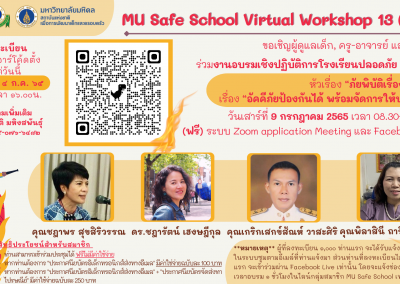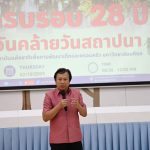![]()
![]()
![]()
![]()
![]()
Written by Dr. Chadarat Hengsadeekul
In 1989, the World Health Organization (WHO), Department of Violence and Injury Prevention, gathered experts in safety and injury prevention in Stockholm to discuss community-based safety and injury prevention with the movement which became known as the International Safe Community. The term Safe Community implies that the community aspires to safety in a structured approach with creative methods of education and environmental changes. New initiative has also been launched later on, the Safe Schools within a safe community context to bridge the gaps between schools and greater communities. Likewise, the term Safe School implies that the school community and its surrounding community, ie. parents, teachers, students, school staff, and businesses, etc., are committed to continually striving to build a safer environment for the children.
In 2007, Child Safety Promotion and Injury Prevention Research Center (CSIP) led by Assoc. Prof. Adisak Plitpolkarnpim, the Head of CSIP & the Director of NICFD currently, connected with Safe Communities Foundation New Zealand (SCFNZ) to start the Safe School program in Thailand. 3 schools in Thailand were certified by International Safe Community Certifying Centre (ISCCC) at that time. Safe school network has been set up to link with schools and children agency networks such as The Center for the Protection of Children’s Rights Foundation and Thai Safe School to launch Online Comprehensive School Safety Module as a guideline for school safety management.
In 2019, MU Safe School Program, in charged by Chadaporn Suksiriwan, R.N., the researcher at CSIP in cooperation with National Institute for Child and Family Development (NICFD) has been launched to mobilize the school safety in Thailand. The key program component will focus effort in school actions for school safety. Schools are encouraged to participate in virtual workshops and engage in school safety projects. Schools that commit actions and resources to school safety continually and are approved by MU Safe School Committee will receive MU Safe School Membership Recognition with a support in achieving the key indicators for International Safe School Designation by International Safe Community Certifying Centre (ISCCC).
Since originating the program, the MU Safe School working team have supported online education and facilitated discussion on school safety through online learning called “Virtual Workshop Safe School” (VWS). Up to date, the VWS has been conducted for 12 different sessions in fulfilling the indicators for safe schools. The theme of each VWS separates into 3 sections, joining by speakers from different areas - - first speaker often are pediatricians or experts from child working network ie: Health Systems Research Institute, Thai Health Promotion Foundation, Healthy Media Hub, Child Media, etc. second are the good practices from schools, third speaker from academic and about learning design. Dr. Chadarat Hengsadeekul, the lecturer of NICFD master program in “Innovation for Child Development and Protection” whose strength is designing active learning activities always offers interactive learning model ie: VWS 11 on how to keep students energetic with learning activities and VWS 12 on how to design safety awareness for students.
As updated from the VWS 11 in April 2022 titling “3Fs: Food, Fat, Fitness in Children”, there are both individual and organization members. It showed more than 30,000 members including parents, teachers, school staffs and public, and more than 12,000 organization members from nationwide schools and child care centers. Registered and attended audience for VWS11 were more than 3,000 people. Survey response was at 2,916. Learning channel was on Zoom and Facebook platform. Voice of audiences was that topics and contents were highly interesting, usable for self development, for work and for workplace, and accessible for teachers in other provinces.
Schools are a location where children spend a significant amount of their day. Under the implementation of the program, it promises on the safe environment to reduce all kinds of child risk and unsafety. The program highlights education and supports that promote safety, good health, well being, strong institutions and in response to the Sustainable Development Goals No. 3, 4, 16 and 17
CF : Sustainable Development Goals (SDGs)
16 Peace, justice and strong institutions
17: Partnerships for the goals








